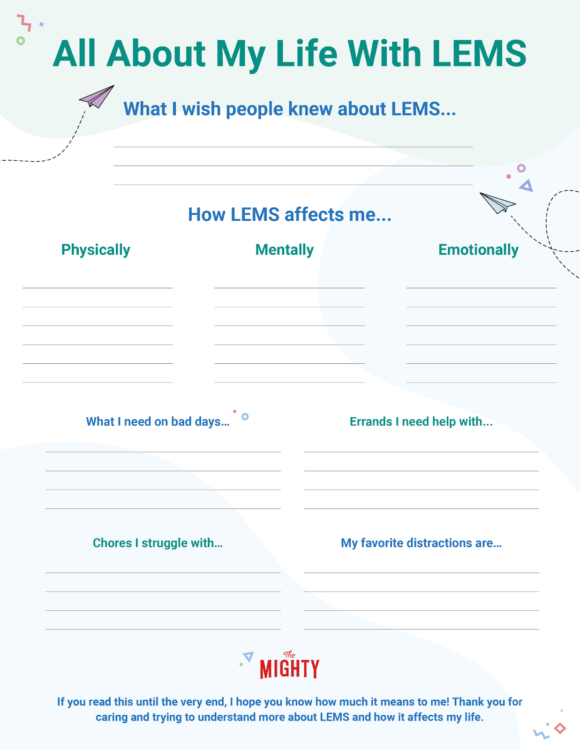The Mighty's Lambert-Eaton Myasthenic Syndrome (LEMS) Condition Guide
Editor's Note
The Mighty’s educational content combines the expertise of both the medical and patient community to support you and your loved ones through your health journeys. For this Lambert-Eaton Myasthenic Syndrome (LEMS) condition guide, we talked with a LEMS expert, read the latest studies and connected with more than 15 people living with this rare condition, and caregivers.
Lambert-Eaton Myasthenic Syndrome at a Glance:
- Lambert-Eaton Myasthenic Syndrome (LEMS) is a rare neuromuscular condition that primarily affects muscle strength and the autonomic nervous system.
- Approximately 3,000 people live with Lambert-Eaton Myasthenic Syndrome (LEMS) in the United States. However, because LEMS shares many overlapping symptoms with other conditions and is often misdiagnosed, there are likely many more undiagnosed cases.
- Despite its rarity, there are several options for LEMS, including medications and lifestyle changes. Sometimes, however, finding the best treatment for an individual is a matter of trial and error.

Medically reviewed by Dr. Samir Macwan, M.D.
What Is Lambert-Eaton Myasthenic Syndrome (LEMS)? | Common LEMS Misconceptions | Managing LEMS | How To Find a Health Care Provider for LEMS | Mental Health and LEMS | How To Talk To Others About LEMS | How To Support Someone With LEMS |
What Is Lambert-Eaton Myasthenic Syndrome (LEMS)?
Lambert-Eaton Myasthenic Syndrome may seem like quite the name at first, but never fear — most people refer to the condition by its acronym, LEMS. LEMS is an autoimmune condition that primarily affects muscles closer to the center of the body, like the muscles in your hips, thighs, upper arms and neck. In order to best understand how LEMS affects the body, we’re going to take a quick dive into a little bit of science. Don’t worry — it won’t get too intense! We promise.
To begin with, we’ll go over a few terms that might be helpful to know when discussing LEMS, both in this condition guide and with your doctor:
- Proximal muscles — muscles toward the center of the body
- Neuron — specialized type of nerve cell that allows the brain to communicate with other parts of the body
- Neurotransmitters — chemical messengers that help your neurons and muscle cells communicate
- Calcium channel — special opening for calcium to enter the neuron
- Acetylcholine — neurotransmitter important for muscle contraction
- Autonomic nervous system — the part of your nervous system that controls unconscious bodily functions like breathing and heartbeat
- Autoimmune — when your body mistakenly attacks itself
- Paraneoplastic — abnormal immune response from a cancerous tumor that causes the body to attack the nervous system
- Small cell lung cancer (SCLC) — cancer type that can be associated with a LEMS diagnosis
- Bulbar — nerves that specialize in swallowing and speech
Ready? Let’s get started!
Imagine you have some delicious ice cream in your freezer, just a few steps away. When you want to take a step, your brain tells the muscles in your leg to contract. This command begins with an electrical signal passed between neurons. The signal happily moves from neuron to neuron until it reaches your muscles. Now, here’s where it can get tricky. Neurons and muscles don’t speak to each other through electrical signals, but rather chemical signals called neurotransmitters.
When the electrical signal reaches the final neuron before a muscle, it will cause calcium from outside of the neuron to rush in through tiny openings called calcium channels. When calcium enters the neuron, it tells acetylcholine (a special neurotransmitter) to pack up and ship out of the neuron toward the muscles. Muscles need acetylcholine to contract, and will do so when they receive enough of it. Repeat this action a few more times and you’re already fetching the pint of ice cream from the freezer. Whew! Now you know how muscle contraction works.
You may be asking yourself: Where does LEMS fit into this conversation and how does LEMS cause muscle weakness?
LEMS is an autoimmune condition that targets the calcium channels in neurons. When a person has an autoimmune condition, the body mistakes a part of itself for a foreign invader and attacks it. In LEMS, the body attacks these critical calcium channels, reducing the amount of acetylcholine that leaves the neuron.1 As hinted before, a muscle can be a little bit picky. It won’t contract unless a certain amount of acetylcholine comes its way. If there’s not enough acetylcholine, there won’t be a muscle contraction. This situation is what causes muscle weakness.
Although muscle weakness in the legs and arms is the most common symptom, other symptoms of LEMS include:2
- Fatigue
- Muscle aching
- Difficulty walking
- Difficulty raising arms or lifting objects
- Weakness in the facial muscles or eyes
- Difficulty swallowing
- Blurred or double vision
LEMS may also affect the autonomic nervous system. This part of the nervous system controls our automatic body functions, like breathing, sweating and heartbeat. People living with LEMS may experience autonomic symptoms such as:
- Dry mouth
- Dry eyes
- Dizziness
- Erectile dysfunction
- Constipation
- Difficulty breathing
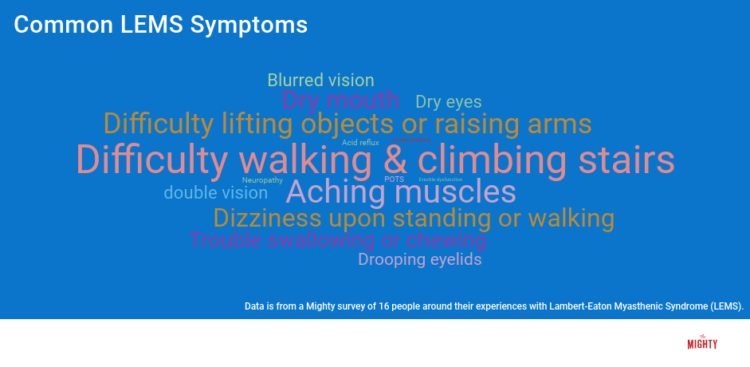
Tumor-Associated and Autoimmune LEMS
The most common comorbidity, or condition, associated with LEMS is small cell lung cancer (SCLC). It is estimated that 60% of patients who have LEMS also have SCLC.3 Because of this, anyone diagnosed with LEMS should quickly be screened for SCLC. If diagnosed with an associated cancer, patients are considered to have paraneoplastic LEMS versus autoimmune-only LEMS.
Why is small cell lung cancer related to LEMS?
Interestingly, the calcium channels on SCLC cells are very similar to the calcium channels on neurons. Because of this similarity, the body attacks the calcium channels on the cancer and accidentally attacks the calcium channels on the neurons too. That’s why patients with SCLC may also have LEMS symptoms.
Even though the probability of having SCLC with LEMS is high, not every LEMS patient will develop it.4 There are people who live with LEMS who don’t have SCLC. This form of LEMS is considered autoimmune-only LEMS.
Common Lambert-Eaton Myasthenic Syndrome Misdiagnoses
Receiving a LEMS diagnosis can be difficult, not only because it’s rare but also because LEMS symptoms mimic many other conditions. On average, it takes 18 months for a LEMS patient without an associated tumor to receive the correct diagnosis.5 If the patient has already been diagnosed with SCLC, it takes an average of four months to receive a LEMS diagnosis. However, patients have gone 20 years with undiagnosed LEMS.6 This diagnosis time is reflected in The Mighty community: 40% of the people we surveyed said it took them more than five years to receive a LEMS diagnosis.
Common LEMS misdiagnoses include:
- Myasthenia gravis (MG)
- Postural orthostatic tachycardia syndrome (POTS)
- Generalized myopathy
- Multiple sclerosis (MS)
- Guillain-Barre syndrome
- Fibromyalgia
- Lupus
We interviewed three LEMS advocates about their misdiagnosis stories. If you are feeling frustrated by a series of misdiagnoses, the following stories may show that you’re not alone in this journey. Here’s what one patient had to say:
“Make sure you advocate for yourself, make it known how much your life has changed, and don’t give up until you get a diagnosis. Find a doctor who’s like you – someone who just won’t give up. Sometimes it feels impossible, but it’s not. There will always be someone down the road to help you or to give you an answer.”
What Is the Difference between Myasthenia Gravis and Lambert-Eaton Myasthenic Syndrome?
Myasthenia gravis is the most common misdiagnosis for LEMS. There is significant overlap of symptoms between the conditions and differentiating between the two can sometimes be difficult. Both LEMS and MG share muscle weakness (myasthenia) as a major symptom. Both conditions involve a lack of acetylcholine in the muscles that causes weakness. The key difference between the two conditions is the source of the muscle weakness.
Recall from the ice cream example earlier that LEMS is caused by less of the neurotransmitter acetylcholine, reaching the muscles. MG has the opposite problem: plenty of acetylcholine may be around the muscles, but it’s not able to connect with muscles, making it hard for them to contract.
Because of this slight difference, symptoms of LEMS and MG can be somewhat different. A LEMS-aware physician will recognize some of these differences:7
- First symptom of LEMS is often muscle weakness in the legs and arms
- First symptom of MG is usually eye drooping
- Some of the first symptoms of MG can also include weakness in the muscles that control swallowing and chewing (bulbar weakness); this is rarer in LEMS.
If you’ve been diagnosed with MG and have symptoms unique to LEMS, please speak with your doctor about the possibility of a LEMS diagnosis.
How Is Lambert-Eaton Myasthenic Syndrome Diagnosed?
Many people living with LEMS talk about their long journey to receiving the final LEMS diagnosis. Unfortunately, this journey is often due to the overlapping symptoms LEMS has with other conditions and lack of awareness for LEMS itself. The good news is that once LEMS is suspected, tests can help support confirm a diagnosis.
As mentioned before, LEMS is caused by a miscommunication between the nerves and muscles, making it difficult for your muscles to contract. Therefore, the diagnostic testing tries to determine the source of muscle weakness. The presence or absence of SCLC is also a clue.
Some tests that are used to determine a LEMS diagnosis include:8
- Electrophysiological studies measure muscle contraction and strength
- Repetitive nerve stimulation measures the activity of muscles and nerves after forced contraction
- Antibody testing determines if you have autoimmunity for the calcium channels in neurons that produce the muscle weakness in LEMS
- Chest imaging screens for SCLC
Scientists are still trying to figure out the relationship between SCLC and LEMS, as well as autoimmune triggers for LEMS. There are some known risk factors, including a history of smoking tobacco and having other autoimmune diseases. We also know that LEMS most often affects people who are middle-aged or older, though it can occur in people of any age. Symptoms most commonly appear at age 60. The most current research suggests that men and women are equally affected.
If you’re feeling apprehensive about navigating a LEMS diagnosis, there are resources available to help give you back some control. LEMS advocate Romy had this to say about going through the diagnostic process.
“We all need to be our own patient advocates, and doctors appreciate when you bring in your own research. [For me], everything’s together: I take notes and collect clinical pictures — those are all important things to help get a diagnosis.”
Below you’ll find a resource we created to help you visually track your diagnosis journey. You can print and save this patient timeline to share with your doctor. It should be especially helpful to a new specialist who doesn’t know your story yet. We kept the specific timeline open, so you can record notes over the span of weeks, months or even years. We hope you find it useful and are empowered to share it with others, too.
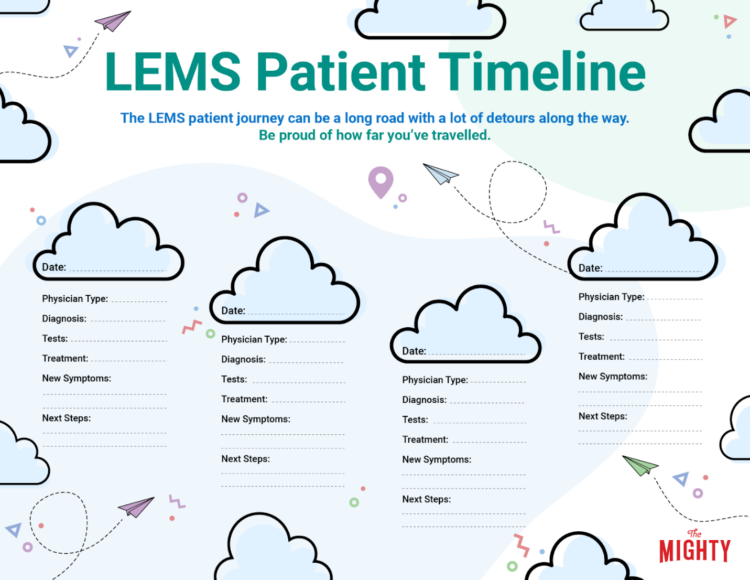

Common Lambert-Eaton Myasthenic Syndrome Misconceptions
LEMS can be extra challenging because it doesn’t just affect your muscles. It can also affect your mental health due to the anxiety and uncertainty caused by its impact on your ability to carry out daily activities and your job performance. Adding to this stress is the fact that LEMS is a very rare condition. You may need to explain it and clarify misconceptions over and over again to your caregivers, loved ones and even healthcare providers. This situation can get very tiring!
Because LEMS symptoms aren’t always obvious, patients sometimes don’t outwardly appear sick. In their responses to The Mighty’s LEMS survey, people living with the condition said LEMS can be an invisible disease; looking healthy on the outside doesn’t necessarily mean you’re healthy on the inside. They also said it’s very difficult to get others to understand how they feel or even believe that LEMS is a real disease.
One Mighty member expressed frustration over these misconceptions:
“The main problem is one of ‘appearance.’ I don’t look unwell. It is very hard to get people to understand my condition [and] it seems way beyond their comprehension. It’s hard to relay that I live within my own ‘private hell’ [of] losing 60% of my living capacity. What, to most people, seems invisible is unfortunately REAL!”
Another member spoke of how frustrating well-meaning but unhelpful advice can be.
“It’s not all in my head. While meditation, yoga, mindfulness practice and relaxation are all helpful, that is not ‘all’ I need to do. Telling me that it is ‘just’ anxiety or that I need to work out more to build strength or eat the way they eat, is all not helpful and actually quite frustrating.”
LEMS can sometimes impact coordination when walking due to muscle weakness. LEMS advocate Romy shared her experience with people mistaking LEMS symptoms for alcohol intoxication:
“I have had the police called on me two different times for ‘public intoxication.’ [Once], when I was at Starbucks picking up my coffee, I walked in and I was staggering. [On my way out] I saw the police officer blocking my car. All of a sudden I heard ‘Bang, bang, bang’ and a police officer was at my window. He said ‘Somebody called that was concerned that you might have been intoxicated:’ And I said, ‘I have [LEMS]. I’m sorry.’”
No matter what others believe, we recognize that your life with LEMS is very real. Your experience is incredibly valid and we see you. To learn more about what people living with rare and invisible illnesses have to say about misconceptions, check out these stories:

Managing Lambert-Eaton Myasthenic Syndrome
Because LEMS is different for everyone, you and your health care team will develop an individualized treatment plan.
It can be scary to be diagnosed with a rare condition, but Dr. Amir Macwan, neurologist from Eisenhower Medical Center, wants you to know:
“LEMS is not a neurodegenerative disorder, a condition that causes permanent loss of function, and it typically will not keep getting worse and worse over time if treated correctly.”
If you or a loved one is anticipating a LEMS diagnosis or has just been diagnosed, know that being here and reading this condition guide is a great first step. There are ways to treat and manage it.
Treatment regimens for LEMS will, in part, depend on whether your LEMS is related to SCLC or another autoimmune disease. In addition to prescribing medications that treat the symptoms of LEMS directly, your health care provider will treat these underlying conditions. Once the underlying conditions improve or resolve, the symptoms of your LEMS usually improve as well.
LEMS is a condition that can get worse over time if left untreated. Like other autoimmune diseases, LEMS isn’t curable and treatment will focus on managing symptoms.
If you looked up LEMS online after you received the diagnosis, you may be overwhelmed by what you have found. You may be asking yourself:
- How will LEMS affect my day-to-day life?
- What does treatment for LEMS look like?
- What is the prognosis for patients with LEMS?
Because LEMS is a chronic illness, the goal of LEMS management is to reduce the severity of your symptoms and prevent their progression. With appropriate treatment, most people living with LEMS report that their symptoms are stable and manageable; however, disease flares can sometimes cause symptoms to worsen temporarily. The progression of your LEMS often depends on the severity of the underlying disease. Prompt diagnosis and treatment of related underlying conditions is very important. Since SCLC is the most commonly associated condition, treatment might include surgery, chemotherapy and/or radiation. If your LEMS is only related to autoimmune disease, treatment may include medications to suppress the immune system.
Although there is currently no cure for LEMS, scientists and doctors have discovered ways to manage it. Most often, these medicines directly affect how your nerves and muscles work together or they target the antibodies that interfere with the communication between your nerves and muscles. These medicines include:9
- Potassium channel blockers, which allow the electrical activity between the nerve and muscles to continue for a longer period of time.
- Cholinesterase inhibitors, which slow the breakdown of acetylcholine, allowing it to build up a bit in the cells
- Medications that suppress the immune system and decrease the number of antibodies
- Intravenous immunoglobulins (IVIG) to block antibodies from targeting your nervous system
Sometimes these medications aren’t enough to control your symptoms. If this is the case, your healthcare provider may recommend a procedure called plasmapheresis. This procedure involves replacing the plasma in your blood, removing harmful immune system proteins that may be making your LEMS more symptomatic.
In addition to medications, there are steps you can take to help manage your LEMS symptoms and avoid flares:
- Avoid hot showers and baths. LEMS symptoms may worsen when you get overheated or have a fever. Contact your healthcare provider if you begin to show symptoms of a cold or flu.
- Regular exercise and physical therapy help maintain muscle strength and tone.
- Getting enough sleep may also help you manage your symptoms.
Living with a rare, chronic condition can be daunting at times but you’re not alone on the journey. Dr. Macwan wants you to know that your healthcare team is here for you:
“[LEMS] is not going to be eradicated, but we have treatment and therapy waiting for you. Showing [my patients] that we are here for them and partnering with them, educating them, this is very, very important.”
To learn more about LEMS management, check out these stories and resources recommended by the LEMS community:
- How the Heat Affects Me as Someone With LEMS
- What it Means When a Rare Disease Gets an FDA-Approved Drug
- LEMS Diagnosis and Treatment Resources
How To Find a Doctor for Lambert-Eaton Myasthenic Syndrome
Finding the right care team for LEMS isn’t easy, but it’s key to getting the best outcome. Where should you begin?
First, try to identify a primary care physician you trust and feel comfortable with. Your primary care physician can help you find the right specialists to help in your care.
Different healthcare professionals can manage LEMS, including:
- Primary care physician (PCP)
- Neurologist
- Cardiologist
- Oncologist (if you have SCLC)
- Occupational therapist/ physical therapist
- Gastroenterologist (GI)
- Mental health professional to help with the impacts of LEMS on mental state
Price, a LEMS patient advocate, shares his advice on where to start:
“The first thing I’d tell somebody, [is] first go find yourself a neurologist who understands neuromuscular diseases.”

Do you track symptoms?
Tracking your LEMS symptoms can be an important tool for two reasons: one, it can help you better understand how LEMS may be affecting you; and two, the information can help inform future treatment options. That’s why our partner created this downloadable tracker journal to help you organize and record your symptoms. When you download the journal, you’ll also have access to a discussion guide that may help you navigate discussing your LEMS with a physician.
You can also find other LEMS resources here:
- LEMS physician locator tool
- Know The Difference Behind Symptoms Infographic
- Is It LEMS? Educational Video
- Additional LEMS information and resources

Other Ways To Manage Living With LEMS
If pain, fatigue and weakness from LEMS keep you from performing daily activities in the ways you are used to, you might be wondering what can help? Depending on the severity of your LEMS, you may need adaptive devices to help you with things like walking, speaking, eating, dressing and grooming yourself.
If you need this type of assistance, an occupational therapist will be a valuable member of your healthcare team. The occupational therapist will help you live as independently as possible. Recommendations may include:
-
- Eating utensils with grip aids if you have difficulty with grasping and fine motor skills
- Technological devices to make speaking or communicating easier
- Specialized hygiene tools to assist you with grooming.
- Assistive devices for the kitchen like specialized knobs for cabinets, tap turners for faucets, easy openers jars and other cooking aids to help you prepare meals for yourself
- Canes, walkers, wheelchairs and power scooters to aid in mobility and help with fatigue

Mental Health and Lambert-Eaton Myasthenic Syndrome
It’s important to remember that living with LEMS can also affect your mental health.
A recent study showed that LEMS impacts mental health as well as physical health.10 In fact, 80 percent of our Mighty community members with LEMS said that the condition has affected their mental well-being.
Price, a LEMS advocate, shares his experience:
“LEMS can be very, very emotionally difficult because [of all the] lifestyle changes and modifications. A LEMS patient has to make decisions about what they think they can and cannot do. You have to calculate every day: Am I feeling really good today? Am I feeling pretty weak today?”
Research suggests that people who have depression and another health condition experience more severe symptoms of both.11 They may have more difficulty accepting and adapting to their medical condition, and they also may have higher medical costs. The stress of living with a chronic illness can also take its toll. Managing symptoms and keeping up with treatments may change the way you feel about your life and contribute to depression. Your healthcare team can help, but only if you share your thoughts and feelings with them.
Dawn, a LEMS patient advocate, had this to say about the impact of working with a mental health care professional:
“There’s no way that I would be in a decent mental state and it wasn’t for [my therapist]. I don’t have co-workers to bounce things off of and I wouldn’t bounce anything medically off them. But [my therapist] is a part of that support system. I think [having a therapist] is really important for LEMS patients. You can get caught up in your own little world and [the therapist can help with that].
It can be hard to be vulnerable, but opening up to your health care provider and a therapist is important. These conversations may give you coping strategies and treatment options to improve your quality of life.
We surveyed the LEMS community about their go-to coping strategies. Do you have a helpful strategy that’s not listed? Feel free to add your suggestions to the comments section at the bottom of this condition guide!
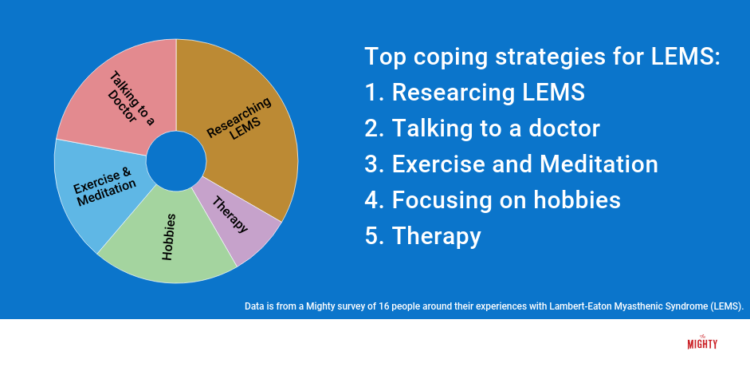
Dawn also shared this about how she copes with LEMS:
“Finding a way [to organize] my meds [in a way] that works for me has been important [and gives] me a little bit more control over my life. But I also, unless I’m really sick, I walk my dog every day. 99.9% of the time, I feel a lot better once I get outside and get that fresh air. I’ve [also] been concentrating on reading and doing the simple things [like] eating healthy [and listening to] music.”
Connecting with other LEMS patients can make a substantial difference in how you cope. If you’re looking for peer support, we recommend you seek out a LEMS-specific community. Sometimes, just knowing there’s someone else who truly gets it can have a powerful impact on your mental health. Price shares his experiences:
“I know what a benefit it is to be in a community of like-minded people who either have the same interest or the same problem, because you can talk with them. You can ask questions, you can compare notes, you can seek advice, you can benefit from what others have gone through already… The groups on Facebook, social media… that was a big deal for me and ultimately has led to a lot of things for me… that have changed my path from there forward.”
If you’re looking for a LEMS community check out these stories from fellow LEMS advocates on The Mighty:
- When You Start Experiencing Symptoms Again After a Period of Remission
- The RARE-est of Friends: Finding Others With LEMS
How to Get Help In a Crisis
If you’re struggling with suicidal thoughts, know you are not alone. There is help for people who feel suicidal. If you need help right now, you can call the National Suicide Prevention Lifeline at 1-800-273-8255 or text “START” to 741-741. Head here for a list of crisis centers around the world and visit our suicide prevention resources.

How To Talk To Others About Lambert-Eaton Myasthenic Syndrome
Talking with others about your LEMS journey can be difficult, especially if they aren’t familiar with the condition. Because LEMS can have invisible symptoms, others may not fully understand the toll it takes on your physical and mental health. If you also are diagnosed with SCLC, trying to understand two new diagnoses at the same time can be challenging to navigate with others as well.
While juggling new diagnoses and trying to find your balance can be draining (you’re doing a fantastic job, by the way), we hope you can feel comfortable talking about what you’re going through, whether that’s with your doctor, your friends, your partner or even a fellow Mighty on our app. No matter what, our Mighty community is here to help. We’ve got your back.
Talking To Friends and Family About LEMS
You’ve probably had a situation or two where a family member or friend wants you to participate in an activity that LEMS makes tough. For example, they may not know that sitting outside on a hot day or walking for long periods of time can worsen your symptoms. It may be tempting to just “fake it ‘til you make it” for a while. But eventually your symptoms become overwhelming and then you pay for it for days afterward.
Being open with your family and friends about your limits and needs doesn’t make you “too much.” Saying “no” won’t make you a “worse” friend. Your group wants to be with you because of who you are. So be your own best advocate. After all, no one knows your body and its limits better than you do.
Try taking the lead and invite your group to a LEMS-friendly activity:
- Organize a Netflix watch party
- Visit a museum, with rest stops at your favorite exhibits or with your mobility device
- Cook up a new recipe or bake a homemade treat
- Start a virtual book club with friends
- Learn a new craft, especially one that can be done with low or limited mobility
We know it can be tough to communicate your needs and experiences with people in your support system (especially on rough health days), so we created the worksheet below for you to fill out when you’re feeling up to it. Share it with those who are eager to learn more about what you go through with LEMS. We hope this can be a bridge to better communication for everyone. You all deserve it.

How To Support Someone Living With Lambert-Eaton Myasthenic Syndrome
Supporting someone who lives with a rare condition – especially one that’s often misdiagnosed – can be challenging. But here’s the bottom line: Being present and willing to learn more about what they’re going through is what matters most. You don’t have to be a neurologist who specializes in LEMS to be a key supporter for someone living with it.
The key to success is good, open communication paired with active listening. Don’t make assumptions about what they’re going through. Sometimes, you may feel like it’s “nicer” to not invite your loved one to an event, but LEMS advocate Dawn said she feels most supported when she’s included:
“The biggest thing I’d say is to keep including that person into things that you’re doing. If you don’t live with them, still call them, still ask them to go. Because if they can’t, they’ll tell you. Don’t [just] assume that they can’t.”
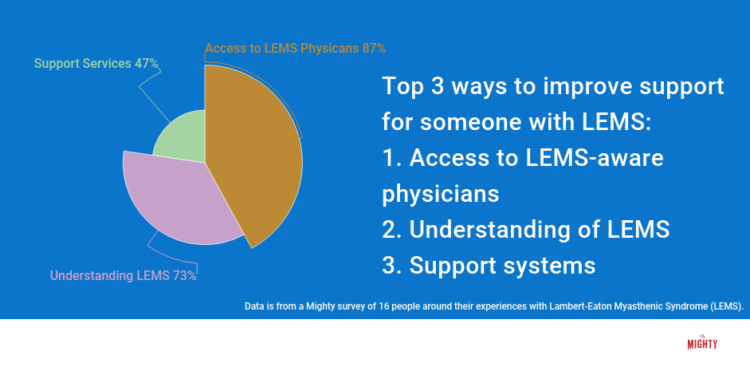
Many people don’t understand just how much LEMS can limit daily activities like shopping for groceries, cleaning the house or traveling to medical appointments. Helping with things like errands and food preparation are great ways to support your loved one. Just reading this educational resource is a thoughtful first step. Thanks for being here.

This condition guide was created with support from many Mighty contributors and medical experts. You can learn more about the individuals interviewed for the creation of this resource here:
- Samir Macwan, M.D.
- Ashley Gregory
- Emily Leininger
- Julianna Kustelski
And to the Mighties who took our LEMS survey: thank you!

1Michael, M., M.D., & Gutmann, L., M.D. (2004). Lambert-Eaton Myasthenic Syndrome. SpringerReference,24(2), 149-153. doi:10.1007/springerreference_116235
https://pdfs.semanticscholar.org/19e8/bd0f1671f652428284f4e9f5e28a06ff6e80.pdf
2Lambert Eaton myasthenic syndrome | Genetic and Rare Diseases Information Center (GARD) – an NCATS Program. (n.d.). NIH: Genetic and Rare Diseases Information Center. Retrieved July 14, 2021, from https://rarediseases.info.nih.gov/diseases/6851/lambert-eaton-myasthenic-syndrome
3Maddison, P., Lipka, A. F., Gozzard, P., Sadalage, G., Ambrose, P. A., Lang, B., & Verschuuren, J. J. (2020). Lung cancer prediction in Lambert-Eaton myasthenic syndrome in a prospective cohort. Scientific Reports,10(1), 1-5. doi:10.1038/s41598-020-67571-9
https://www.nature.com/articles/s41598-020-67571-9
4Titulaer, M. J., Wirtz, P. W., Willems, L. N., Kralingen, K. W., Smitt, P. A., & Verschuuren, J. J. (2008). Screening for Small-Cell Lung Cancer: A Follow-Up Study of Patients With Lambert-Eaton Myasthenic Syndrome. Journal of Clinical Oncology,26(26), 4276-4281. doi:10.1200/jco.2008.17.5133
https://pdfs.semanticscholar.org/d227/c462cdbf9749fead32f20d9197dbcbbe9bf6.pdf
5Lipka, A. F., Boldingh, M. L., Zwet, E. W., Schreurs, M. W., Kuks, J. B., Tallaksen, C. M., . . . Verschuuren, J. J. (2019). Long‐Term Follow‐Up, Quality of Life, and Survival of Patients With Lambert‐Eaton Myasthenic Syndrome. Long‐term Follow‐up, Quality of Life, and Survival of Patients with Lambert‐Eaton Myasthenic Syndrome. doi:10.1212/wnl.0000000000011775
https://n.neurology.org/content/94/5/e511.abstract
6Gokal, E., Gursoy, A. E., Asil, T., & Ertas, M. (2017). Lambert-Eaton Myasthenic Syndrome with A Twenty-Three-Year Delay in Diagnosis. Noro Psikiyatri Arsivi, 54(2), 189–190. https://doi.org/10.5152/npa.2016.12709
7Wirtz, P. W. (2002). Difference in distribution of muscle weakness between myasthenia gravis and the Lambert-Eaton myasthenic syndrome. Journal of Neurology, Neurosurgery & Psychiatry,73(6), 766-768. doi:10.1136/jnnp.73.6.766
https://jnnp.bmj.com/content/73/6/766
8Lambert-Eaton Syndrome. (n.d.). Johns Hopkins Medicine. Retrieved July 18, 2021, from https://www.hopkinsmedicine.org/health/conditions-and-diseases/lamberteaton-syndrome
9Yoon, C. H., Owusu-Guha, J., Smith, A., & Buschur, P. (2020). Amifampridine for the management of lambert-eaton myasthenic syndrome: a new take on an old drug. Annals of Pharmacotherapy, 54(1), 56-63.
https://journals.sagepub.com/doi/full/10.1177/1060028019864574
10Lipka, A. F., Boldingh, M. L., Zwet, E. W., Schreurs, M. W., Kuks, J. B., Tallaksen, C. M., . . . Verschuuren, J. J. (2019). Long‐Term Follow‐Up, Quality of Life, and Survival of Patients With Lambert‐Eaton Myasthenic Syndrome. Long‐term Follow‐up, Quality of Life, and Survival of Patients with Lambert‐Eaton Myasthenic Syndrome. doi:10.1212/wnl.0000000000011775
https://n.neurology.org/content/94/5/e511.abstract
11NIMH » Chronic Illness and Mental Health: Recognizing and Treating Depression. (n.d.). National Institute of Mental Health. Retrieved July 13, 2021, from https://www.nimh.nih.gov/health/publications/chronic-illness-mental-health


